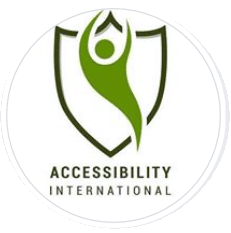I had someone ask me recently why we say accessibility is more important than ever. Hasn’t accessibility (removing barriers to digital access by people with disabilities) always been important? Yes, it has! However, up until the recent pandemic there have been workarounds, alternatives, and fallback approaches that could be used to meet requirements such as the Americans with Disabilities Act and Section 504 of the Rehabilitation Act. As so many activities of daily life have moved solely online, in many cases those alternatives and workarounds are no longer an option.
Changes in How We Learn
In a classroom setting, various accommodations can serve as workarounds for accessible digital content. For example, it’s not uncommon for a student with low vision to use a video magnification device to read a printout of a digital document that was otherwise not accessible. Accommodations like an enlarged print or read-aloud test may have been provided to a student with dyslexia, or a student with executive function difficulties may benefit from in-class visual supports, reminders, and other prompts from teachers.
Now school has moved online, and a myriad of digital resources are being used to replace the classroom including instructional portals, video conferencing platforms, electronic documents, online tutoring, and other web-based tools and services. Many students are required to use 3 or more different tools to engage online and may have trouble keeping on track. Digital solutions exist to help students but the accessibility, knowledge of, and configuration of these solutions are all things that now must be considered as in-person supports are not available. In addition, parents, guardians, and other caregivers who are providing educational support for students may have disabilities themselves and require accessible materials. Thus, modification of the materials and curriculum must be provided in a digital manner rather than in a physical space.
Changes in How We Work
In an office setting, people with disabilities have access to others in physical proximity to assist with technical challenges and workarounds for accessibility gaps in applications and websites. While our goal is for everyone to be independent, it’s not uncommon for organizations to procure technology that is not fully accessible – perhaps because there is limited market availability, or it was just a simple oversight. For example, almost all current video conferencing and communication software platforms have accessibility limitations. Like everyone, employees with disabilities must now rely on conference calls and online meetings to communicate and collaborate with their teams rather than face to face interaction and in-person meetings. While meeting software can afford access to different communication needs – the bandwidth and features must be present and coordinated to be available.
Use of video conferencing software puts people in the spotlight. For example, use of video means that others are looking at you – and likely that you also see a picture of yourself. These aspects can increase anxiety for some people, causing them to become hyper-focused on how they act, look, and maintain facial expression or eye contact. This can be particularly challenging for some people such as those with low vision, anxiety, and those on the autism spectrum to name a few. Some web conferencing software will even track eye movements and user action to ensure participants are paying attention. For some users with disabilities, their physical attendance in the past may have been sufficient without scrutiny of individual habits – with the new normal, individual habits and other disability-related characteristics are now thrust into the spotlight. These factors, which in the past were less analyzed but now more forefront in our digital communications, will now have to be considered to prevent discrimination.
Changes in How We Shop
When shopping in a store, people with disabilities can ask an employee for assistance with locating a product or providing details and pricing. Physical lines at the store may seem like an inconvenience, but they ensure that everyone is served. Attempting to do grocery shopping via a website or mobile app that isn’t accessible paired with shortages of essential supplies means people with disabilities may not be able to go through a checkout process fast enough before a time slot for delivery expires. When a restaurant’s website or mobile app was not accessible the alternative was to call for service. That’s no longer a viable option when there’s no customer service person to answer the phone and the handful of staff still working are busy preparing food or making deliveries. Accessibility of web and mobile apps for ordering is critical. Providing options for delivery whether it be robot, drone, or human allows people with disabilities to access essential services and items like food and groceries.
Changes in Transportation
Since the pandemic, transportation providers such as Amtrak are considering what service will look like in the new normal. Work is being done to allow customers to order food from the onboard café using the mobile app, and to alert customers with information, instructions, and directions via text, mobile app, and digital signage to reduce the need for human interaction. This work to streamline purchase of tickets, communicate critical information, and reduce physical interactions will certainly need to be accessible and offer multiple methods of communication to meet the varying needs of humans. Physical distancing, face mask wearing, and other safety protocols have an impact on people who are Deaf, hard of hearing, and speech impaired as well as others. New solutions, both physical and digital, will undoubtedly be needed to allow equitable access to transportation in the future.
The Future
The global pandemic has caused significant changes in our society that will likely be here for a long time. This means that the proverbial digital accessibility “can” can no longer be kicked down the road – it must be addressed now in order to ensure an equitable society where the talents and skills of all people can effectively be used for the greater good. The inclusion and accessibility work that must be accelerated because of this pandemic will bring innovation and benefits going forward for all users just as accessibility features like captions, voice control, dark mode, ramps, and automatic doors have improved access for everyone.




